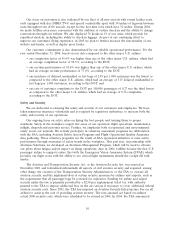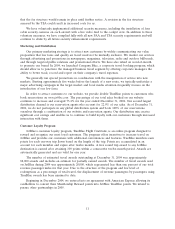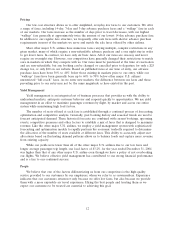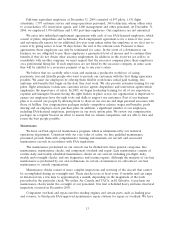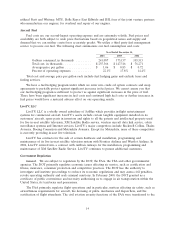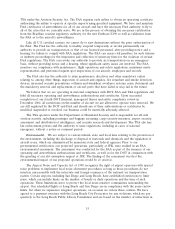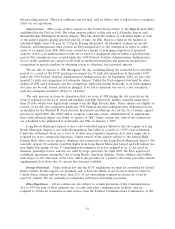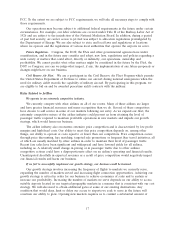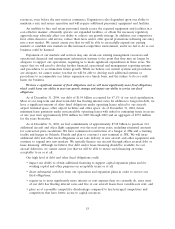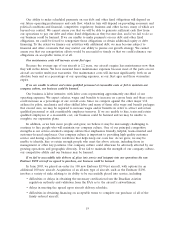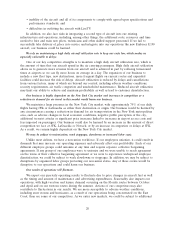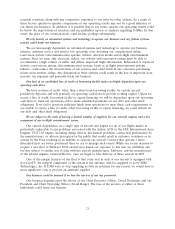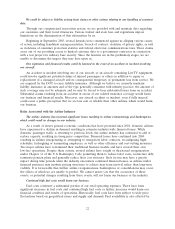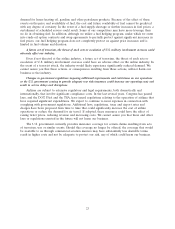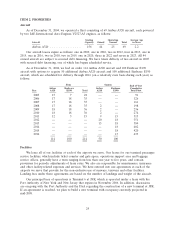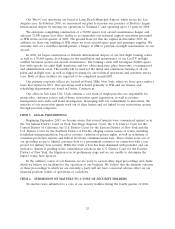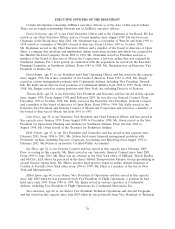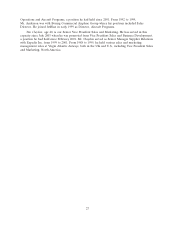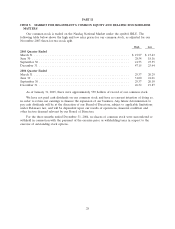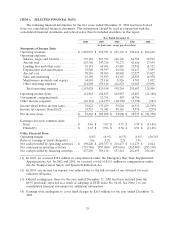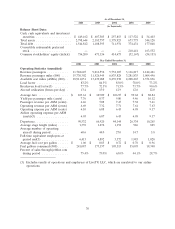JetBlue Airlines 2004 Annual Report Download - page 28
Download and view the complete annual report
Please find page 28 of the 2004 JetBlue Airlines annual report below. You can navigate through the pages in the report by either clicking on the pages listed below, or by using the keyword search tool below to find specific information within the annual report.• inability of the aircraft and all of its components to comply with agreed upon specifications and
performance standards; and
• difficulties in outfitting the aircraft with LiveTV.
In addition, we also face risks in integrating a second type of aircraft into our existing
infrastructure and operations, including, among other things, the additional costs, resources and time
needed to hire and train new pilots, technicians and other skilled support personnel. If we fail to
successfully take delivery of, place into service and integrate into our operations the new Embraer E190
aircraft, our business could be harmed.
We rely on maintaining a high daily aircraft utilization rate to keep our costs low, which makes us
especially vulnerable to delays.
One of our key competitive strengths is to maintain a high daily aircraft utilization rate, which is
the amount of time that our aircraft spend in the air carrying passengers. High daily aircraft utilization
allows us to generate more revenue from our aircraft and is achieved in part by reducing turnaround
times at airports so we can fly more hours on average in a day. The expansion of our business to
include a new fleet type, new destinations, more frequent flights on current routes and expanded
facilities could increase the risk of delays. Aircraft utilization is reduced by delays and cancellations
from various factors, many of which are beyond our control, including adverse weather conditions,
security requirements, air traffic congestion and unscheduled maintenance. Reduced aircraft utilization
may limit our ability to achieve and maintain profitability as well as lead to customer dissatisfaction.
Our business is highly dependent on the New York City market and increases in competition or a
reduction in demand for air travel in this market would harm our business.
We maintain a large presence in the New York City market, with approximately 75% of our daily
flights having JFK or LaGuardia as either their destination or origin. Our business would be harmed by
any circumstances causing a reduction in demand for air transportation in the New York metropolitan
area, such as adverse changes in local economic conditions, negative public perception of the city,
additional terrorist attacks or significant price increases linked to increases in airport access costs and
fees imposed on passengers. Our business could also be harmed by an increase in the amount of direct
competition we face at JFK, LaGuardia or Newark, or by an increase in congestion or delays at JFK.
As a result, we remain highly dependent on the New York City market.
We may be subject to unionization, work stoppages, slowdowns or increased labor costs.
Unlike most airlines, we have a non-union workforce. If our employees unionize, it could result in
demands that may increase our operating expenses and adversely affect our profitability. Each of our
different employee groups could unionize at any time and require separate collective bargaining
agreements. If any group of our employees were to unionize and we were unable to reach agreement
on the terms of their collective bargaining agreement or we were to experience widespread employee
dissatisfaction, we could be subject to work slowdowns or stoppages. In addition, we may be subject to
disruptions by organized labor groups protesting our non-union status. Any of these events would be
disruptive to our operations and could harm our business.
Our results of operations will fluctuate.
We expect our quarterly operating results to fluctuate due to price changes in aircraft fuel as well
as the timing and amount of maintenance and advertising expenditures. Seasonality also impacts our
operations, with high vacation and leisure demand occurring on the Florida routes between October
and April and on our western routes during the summer. Actions of our competitors may also
contribute to fluctuations in our results. We are more susceptible to adverse weather conditions,
including snow storms and hurricanes, as a result of our operations being concentrated on the East
Coast, than are some of our competitors. As we enter new markets, we could be subject to additional
20


